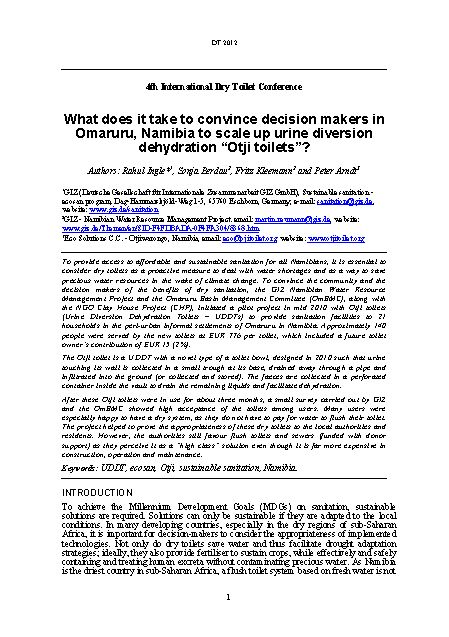What does it take to convince decision makers in Omaruru, Namibia to scale up urine diversion dehydration “Otji toilets”?
Ingle, R., Berdau, S., Kleemann, F., Arndt, P. (2012)

Published in: 2012
Publisher:
4th International Dry Toilet Conference, Tampere, Finland
Author:
Ingle, R., Berdau, S., Kleemann, F., Arndt, P.
Uploaded by:
SuSanA secretariat
Partner profile:
common upload
7844 Views
84 Downloads
Location of library entry
Content - Summary
To provide access to affordable and sustainable sanitation for all Namibians, it is essential to consider dry toilets as a proactive measure to deal with water shortages and as a way to save precious water resources in the wake of climate change. To convince the community and the decision makers of the benefits of dry sanitation, the GIZ Namibian Water Resource Management Project and the Omaruru Basin Management Committee (OmBMC), along with the NGO Clay House Project (CHP), initiated a pilot project in mid 2010 with Otji toilets (Urine Diversion Dehydration Toilets – UDDTs) to provide sanitation facilities to 21 households in the peri-urban informal settlements of Omaruru in Namibia. Approximately 140 people were served by the new toilets at EUR 776 per toilet, which included a future toilet owner’s contribution of EUR 15 (2%).
The Otji toilet is a UDDT with a novel type of a toilet bowl, designed in 2010 such that urine touching its wall is collected in a small trough at its base, drained away through a pipe and infiltrated into the ground (or collected and stored). The faeces are collected in a perforated container inside the vault to drain the remaining liquids and facilitate dehydration.
After these Otji toilets were in use for about three months, a small survey carried out by GIZ and the OmBMC showed high acceptance of the toilets among users. Many users were especially happy to have a dry system, as they do not have to pay for water to flush their toilet. The project helped to prove the appropriateness of these dry toilets to the local authorities and residents. However, the authorities still favour flush toilets and sewers (funded with donor support) as they perceive it as a “high class” solution even though it is far more expensive in construction, operation and maintenance.
Bibliographic information
Ingle, R., Berdau, S., Kleemann, F., Arndt, P. (2012). What does it take to convince decision makers in Omaruru, Namibia to scale up urine diversion dehydration “Otji toilets”?. 4th International Dry Toilet Conference, Tampere, Finland
Filter tags
English Peri-urban Sub-Saharan Africa Urine diversion dehydration toilets (UDDTs)















